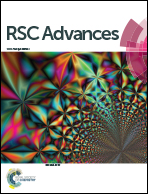Photochemical induced formed Au nanomaterial with size and shape controlled by luminol–pepsin chemiluminescence reaction†
Abstract
Size and shape controlled Au nanomaterials (AuNMs) were generated in different alkaline luminol–pepsin (Pep) chemiluminescence (CL) reaction solutions based on the photochemical induced effect of luminol. These findings showed that luminol photochemical intensity could be used as a major control parameter for metal NMs growth.


 Please wait while we load your content...
Please wait while we load your content...